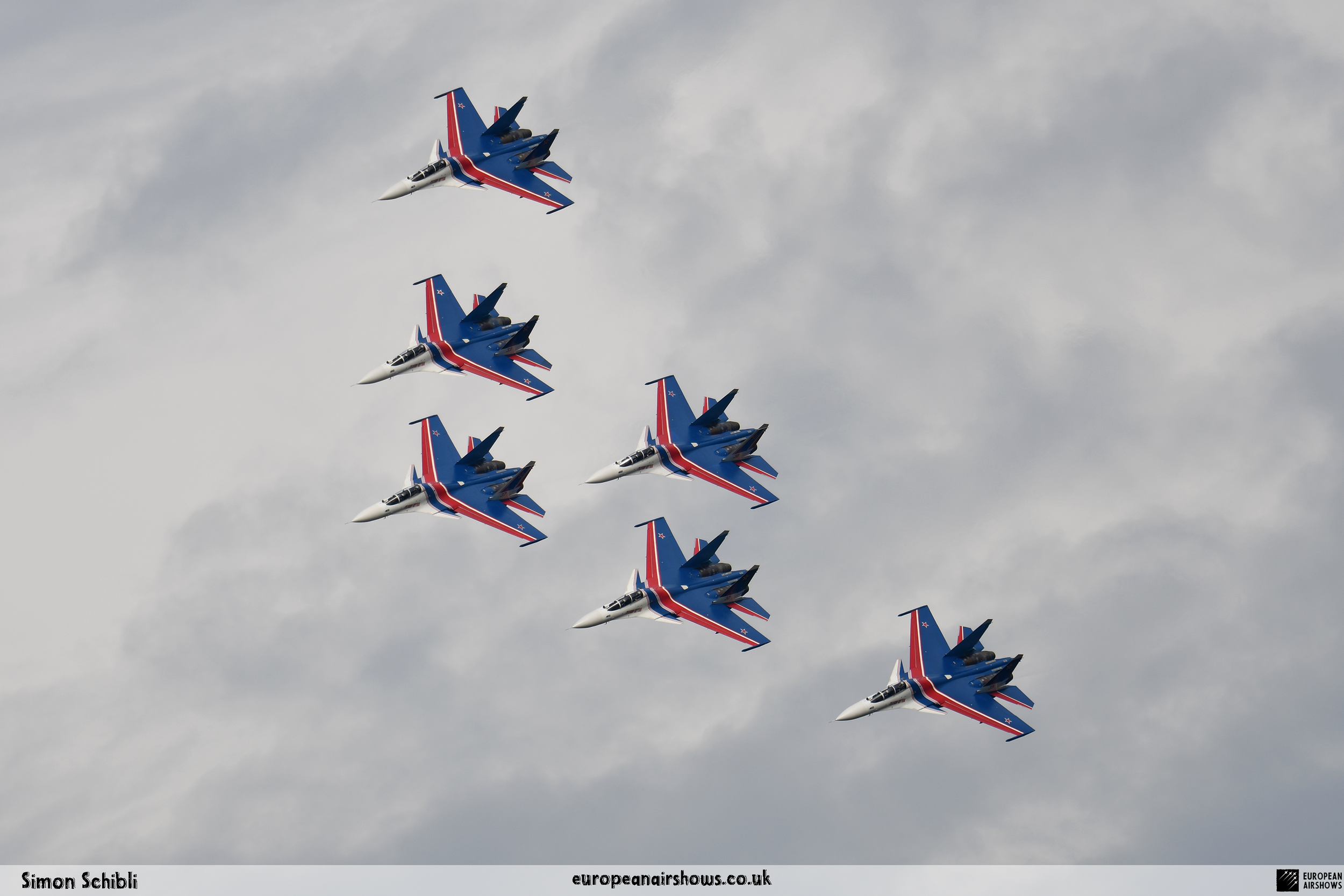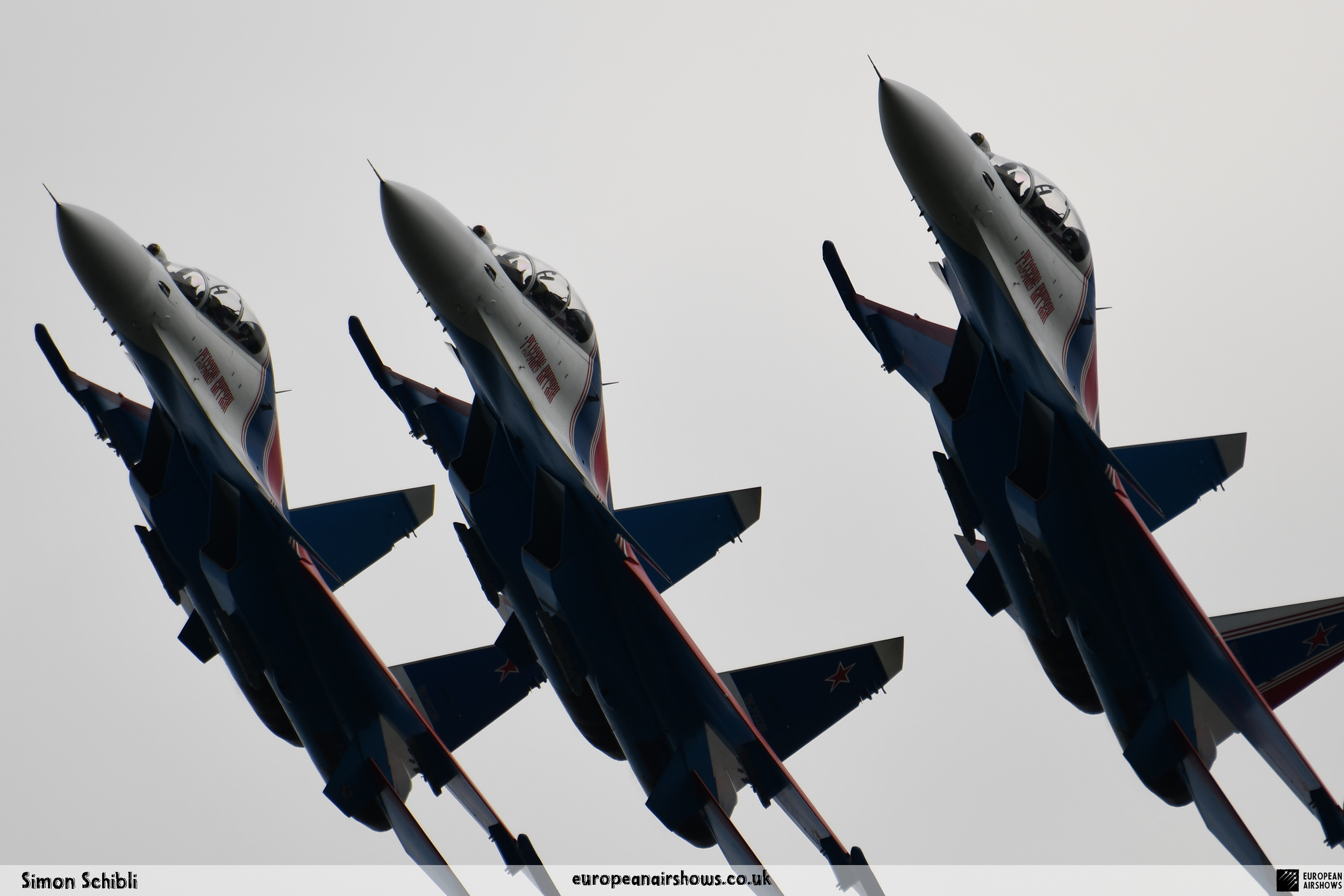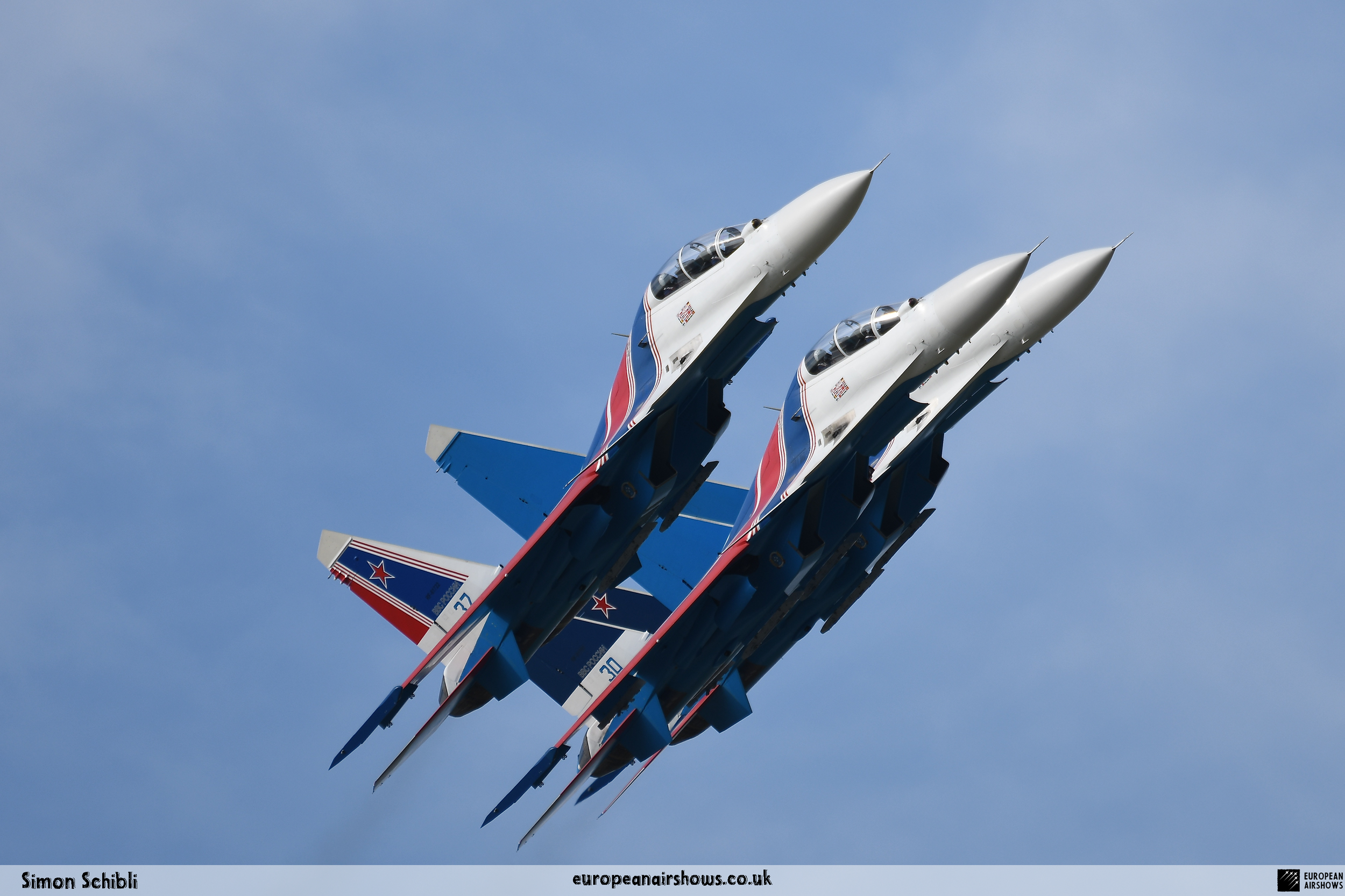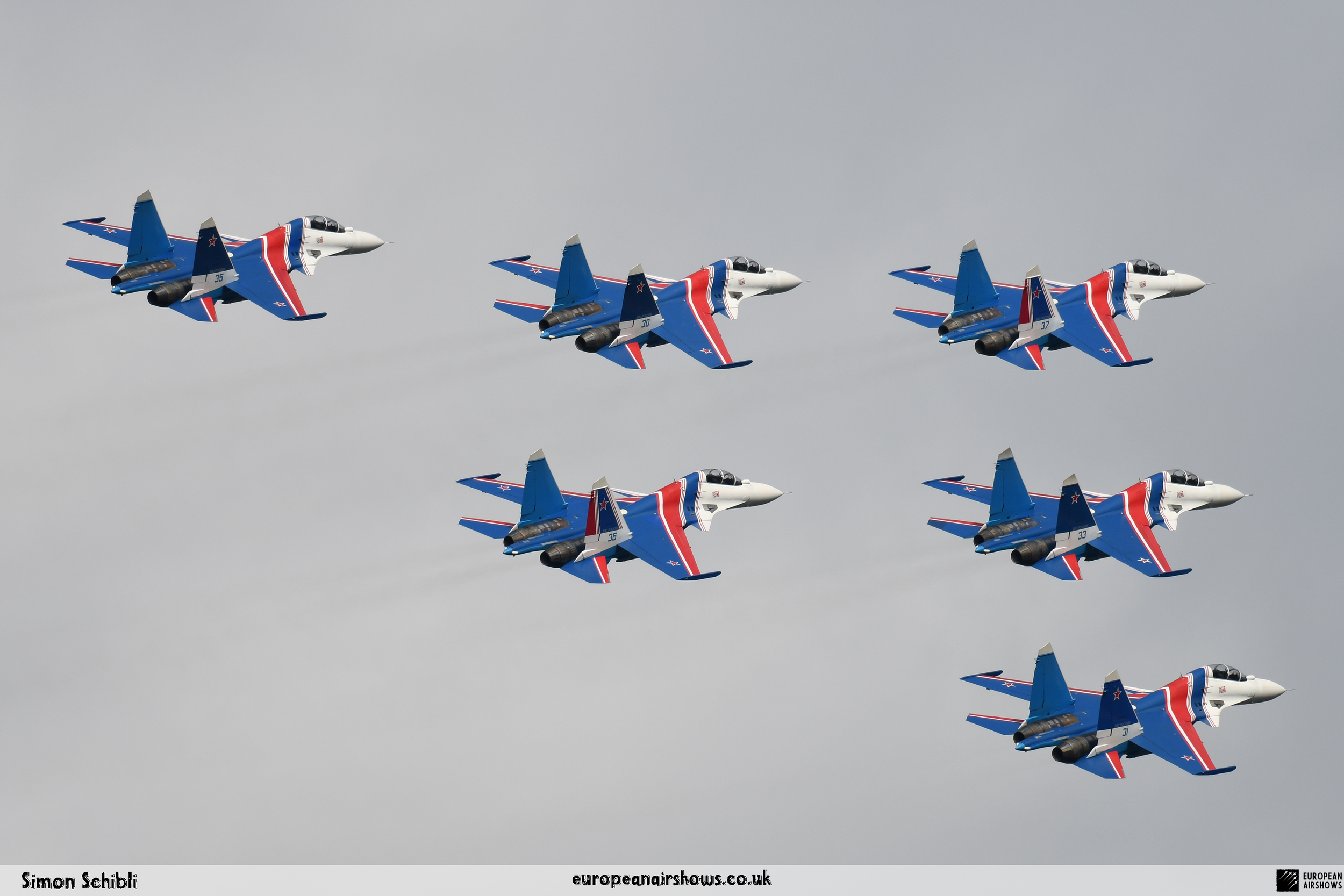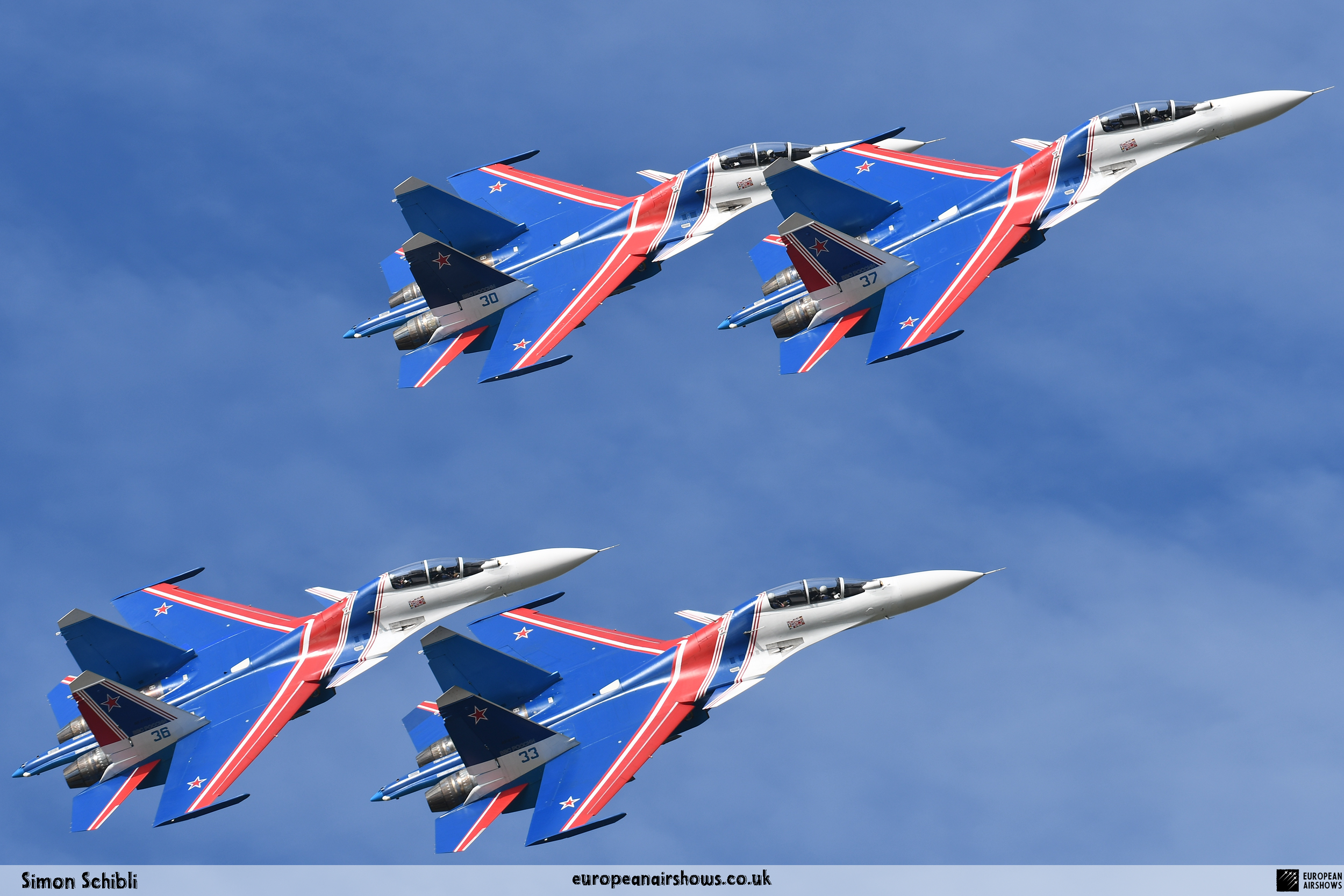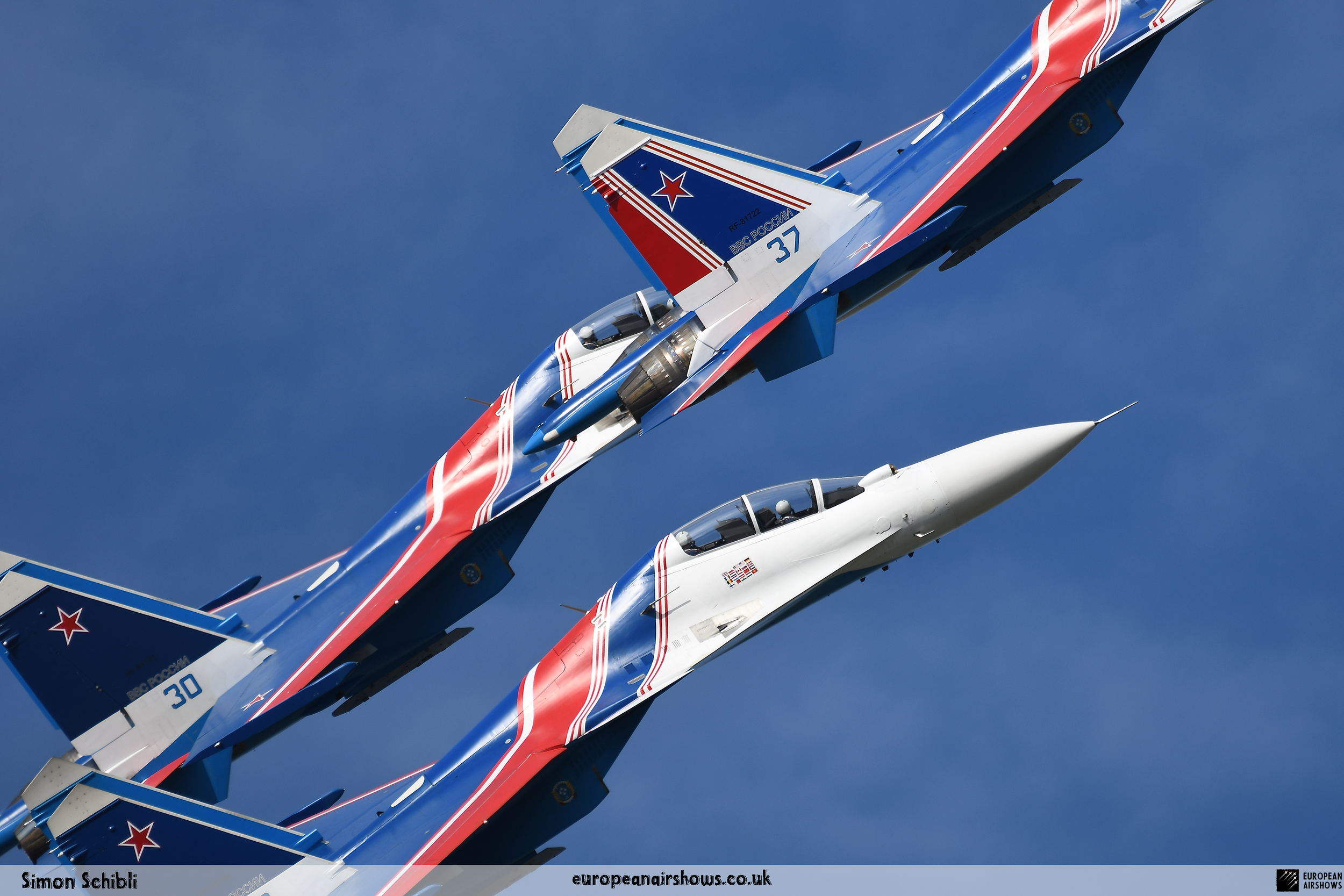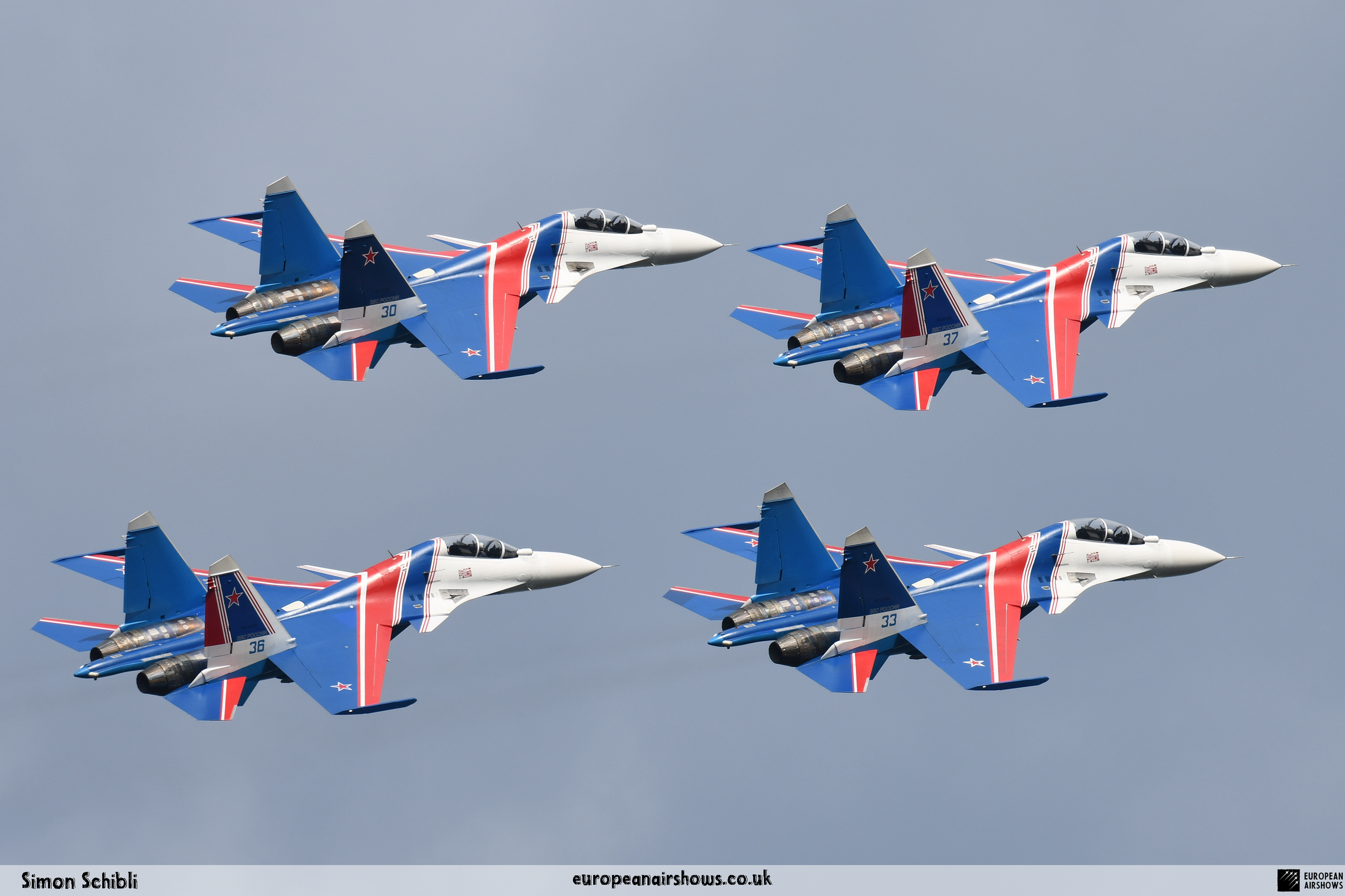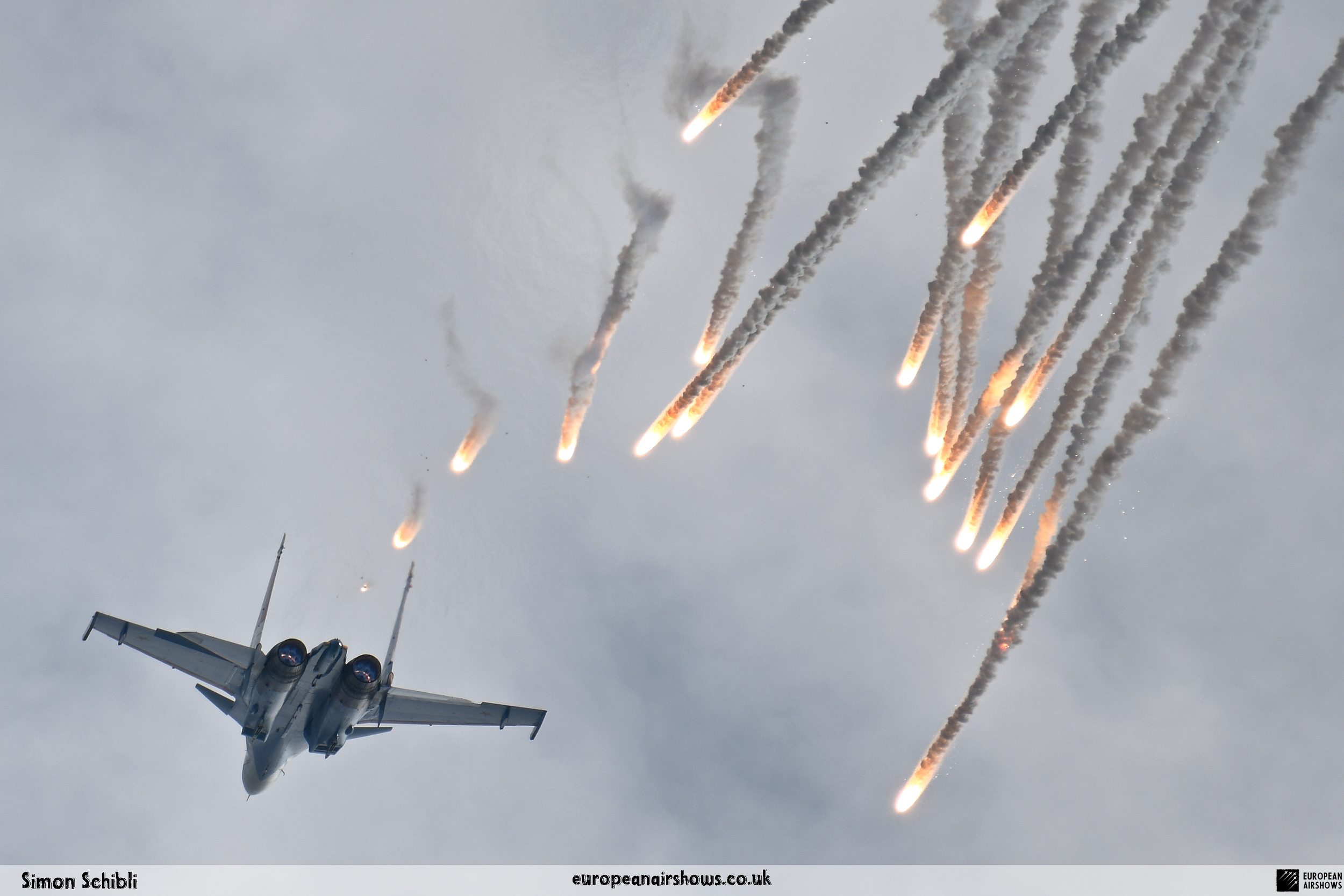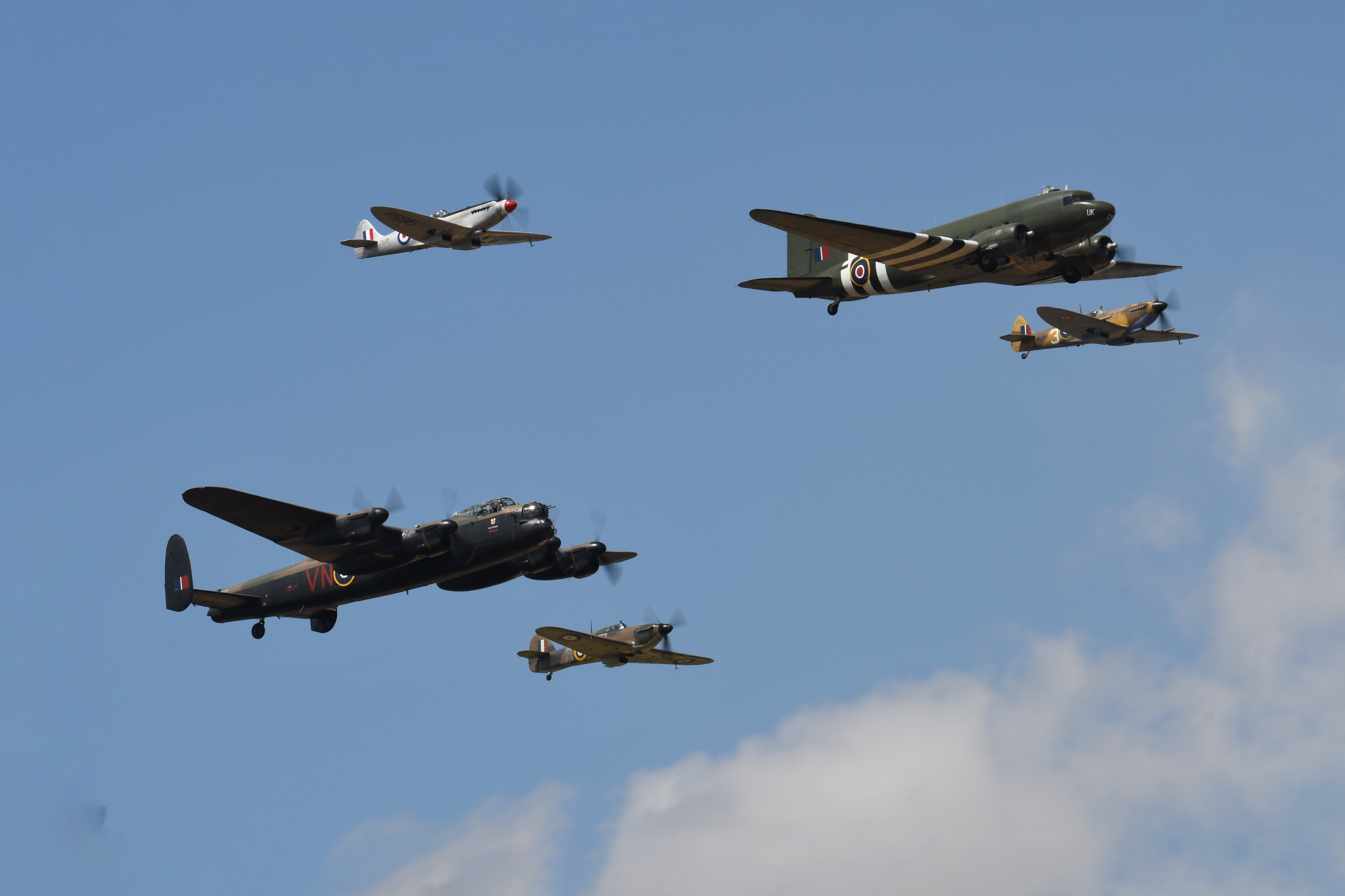Russian Knights
Country
Russia
Size
6 Aircraft
Base
Kubinka Air Base
"Russian Knights" is an aerobatic demonstration team of the Russian Air Force and is the holder of a number of world records. It was formed on April 5, 1991, at the 1st Aviation Squadron of the 234th Guards Proskurovsky Mixed Aviation Regiment of the 16th Air Army, based at the Kubinka airfield near Moscow. The team performs formation and solo aerobatics on multipurpose highly manoeuvrable Su-35S and Su-30SM fighters. In 2016, the group began flying on the new Su-30SM aircraft and In 2019-2020 the team changed the aircraft once again this time for the new Su-35S. The aircraft entered the disposal of the team on November 13, 2019, and July 8, 2020. As a result, the aerobatic team "Russian Knights" has three types of aircraft - Su-27, Su-30SM and Su-35S. The latter is the latest Russian multi-role super-manoeuvrable fighter jet. The uniqueness of the group lies in the fact that it is the only aerobatic team in the world performing formation aerobatics on aircraft of the "heavy fighter" class, as well as the fact that fighters are production models with no special modifications to perform these displays. The group is a constant participant in all Russian and many foreign air shows.
History
In the postwar years, Kubinka pilots flew on Mikoyan Design Bureau fighters - MiG-15, MiG-17, MiG-19, MiG-21, MiG-23 and MiG-29 aircraft. In May 1989, Su-27 fighters entered service with the 1st Aviation Squadron of the 234th Guards Proskurov Fighter Aviation Regiment. Soon, the first training flights were performed as part of a pair, three, and then four aircraft. New aircraft were more difficult to fly in formation due to the size and weight of the aircraft, its inertia and, strangely enough, its aerodynamic properties.
At the beginning of 1991, the team grew to six aircraft, and on April 5th of the same year an aerobatic team was officially founded, which was named "Russian Knights". And already on the 24th of August, only four and a half months later, the name of “Russian Knights” was first heard abroad at the first Polish air show in Poznan. In autumn, 1991, the Russian Knights appeared in the sky above England. Six newly-painted Su-27 aircraft performed above the Queen-mother’s palace in Scotland. The visit to England was continued by the team’s performance at the air shows in Leuchars and Finningley where the “Knights” flew together with British aerobatic team Red Arrows. The same autumn in Prague, the Russian Knights were represented by Vladimir Gryzlov and Igor Tkachenko, who performed in a double seat aircraft Su-27UB with a solo aerobatic program. A month after their return to Russia, the team was invited to participate in the LIMA’91 air show in Malaysia and in June 1992, two dual-cockpit aircraft of the “Knights” were sent to the Rose Festival air show in Portland, USA. And only a month later they visited the USA again.
The Autumn of 1992 was action-packed for the team. Early in September, the Blue Angels aerobatic team of the US Air Force arrived at the airbase in Kubinka. Together with the guests, the pilots performed above their airfield and then presented a picturesque show in honour of the City Day in the sky above Tushino, Moscow. A week later, the “Knights” performed at the 50th anniversary of the famous Normandie-Niemen Regiment in Reims, France, where simultaneous piloting of two groups of four aircraft took place. It was also then the Russian pilots met the French aerobatic team Patrouille de France. At the airfield of Salon-de-Provence, the Russian Knights with Su-27 performed simultaneous piloting with small and light Alpha-Jet aircraft and in April 1993, the team was invited to Holland, where they performed at an air show in Leeuwarden airbase. In August of the same year, the Russian Knights flew to Abbotsford airbase in Canada to take part in the Abbotsford Airshow and in September, the team performed at the first MAKS-1993 International Aviation and Space Salon. In December, the Knights flew to the remote tropical island of Langkawi to take part in the LIMA’93 air show.
The 1994 display season for the Russian Knights began in May when the team flew to Bratislava and participated in the SIAD-94 air show. Capitan Igor Tkachenko, a pilot of the team, who performed above the Slovakian capital with his solo aerobatic program, won an award for the best solo display. In June the team also displayed in Norway and a month later in Belgium where one of the dual seat jets flew to the neighbouring Luxemburg and participated in the Journidelle Air air show.
On the 3rd of September, when Moscow was celebrating City Day, the Russian Knights were performing the most difficult display above Poklonnaya Hill. An area covering about 3 km to the West of the memorial was allocated to display. On the 24th of October the same year, the Russian Knights participated in an air pageant above Ashkhabad as Turkmenistan was celebrating its third independence anniversary. In October, the pilots of the team rekindled the old tradition of Kubinka escorting VIP-guests’ and later that month escorted the aircraft carrying Queen Elizabeth II.
On the 12th of December 1995, a tragedy struck the team when three jets of the team crashed into a mountain on the way back from the airshow in Malaysia. The accident happened in adverse weather conditions when the jets were approaching Cam Ranh airfield in Vietnam to refuel on the way back home. Four pilots of the Russian Knights were killed (Guards Colonel Boris Grigoryev, Guards Lieutenant Colonels Alexandr Syrovoy, Nikolay Grechanov and Nikolay Kordyukov. The pilots of the RAF aerobatic team the Red Arrows supported their colleagues by inviting them to their base.
In September 1996 a newly arranged diamond of four Su-27s in a new bright colour scheme displayed for the first time at the Gelendzhik-96 hydro air show. In 1997 the team grew by two new pilots and at last, in June, a group of six aircraft performed abroad for the first time after a year and a half break. First in Zeltweg, Austria, and then in the Slovakian capital Bratislava. Later in the year, the team paid a friendly visit to France, where they participated in celebrating the 55th anniversary of the Normandie-Niemen Regiment. A bit later, the pilots with their jets escorted the aircraft carrying the French President Jacques Chirac who was paying an official visit to Russia. On return to Russia the team participated in celebrating the 850th anniversary of Moscow, the Russian Knights with four jets flew with the landing gears extended and lights on in the evening sky above Sparrow Hills where Jean Michel Jarre was giving his laser show.
In November 1998, the team participated in the Zhuhai-98 air show in the People’s Republic of China and in late 2000, they visited China once more. On the 12th of June, 2003, on the Independence Day of Russia, a group of ten aircraft flew above the Red Square. At MAKS-2003, the Russian Knights aerobatic team performed again with six aircraft.
In 2004, a simultaneous flight of the Russian Knights and the Swifts aerobatic teams was included in the set of displays, 9 aircraft total (5x Su-27 and 4x MiG-29) in a diamond formation, with a whole set of air stunts. The fact itself set a world record in the history of aviation. Late that year, the group successfully performed at a number of airshows, including the Aerobatic Teams Festival in Zhukovsky, at the World War II Stunt Pilots air show in Monino, and for the third time at the hydro air show in Gelendzhik.
In January 2005, the group visited Arabia for the first time, to participate in Al Ain 2005 air show in the United Arab Emirates.
On the 9th of May, 2005, to commemorated the 60th anniversary of the Victory in the Great Patriotic War, the Russian Knights together with the Swifts aerobatic team performed a historical flight above the Red Square with nine aircraft. A few days later, the team redeployed at the town of Dudinka on the Taymyr Peninsula, where it performed an air display beyond the Arctic Circle for the first time. In the summer of the same year, the team demonstrated their piloting in Saint-Petersburg and Kazan; and in Cherepovets and Vologda, they performed shows at a distance of 800 km from the home airfield without landing. In August, the Knights participated in the World War II Stunt Pilots air show and traditionally performed at the MAKS-2005 air show.
In autumn, the team embarked for the town of Salekhard on the Yamal Peninsula in the Polar Region. After that, they performed in Akhtubinsk in honour of the 85th anniversary of State Proving Flying Centre 929, where the skills of the Russian Knights were evaluated by true professionals – test pilots. Early in 2006, they visited the United Arab Emirates, where in the sky above the Arabian Desert the Knights won first place in the group aerobatic class with jets, as they triumphantly displayed their piloting skills and the supreme qualities of Su-27. The team performed with a new program including a group barbecue spin in a V-formation, a double hook turn and a barrel roll. The pilots were rewarded with FAI (Fédération Aéronautique Internationale) golden medals. In the March and August of the same year, they visited the People’s Republic of China, where the Russian Knights opened the Year of Russia in China and participated in the Zhuhai-2006 International Space Air Show.
On the 5th of April, 2006, the Russian Knights celebrated its 15th anniversary with a superb air show at their native airfield. To maintain the glorious traditions of air pageants above the Red square, a simultaneous flight with the Swifts aerobatic team was performed on the 9th of May, 2007, with nine aircraft. A remarkable event in the history of the aerobatic team was MAKS-2007. That August, for the first time in history, a horizontal barrel roll was performed by a group of nine aircraft, called a “Kubinka Diamond” for its outline and unique qualities.
On the 20th of June, 2008, the Knights performed in Kauhava, Finland, at the Midnight Sun air show. The flights took place in the twilight, in white night condition. Two days were left until the MAKS opening when the group of four “Knights” started a training flight above the display point in Zhokovsky. It was at that training that an irreparable happened. The commander of 237 AESC, the leading pilot of the Russian Knights Igor Tkachenko came to a tragic end. The team participated in the air show was then limited by a diamond flight on the MAKS final day, the 23rd of August. In dead silence, the diamond appeared above the Zhukovski airfield and performed a memorial flight in honour of the deceased Igor Tkachenko. The exclamations expressing admiration with the courage of the pilots and applause in commemoration of Guards Colonel Tkachenko drowned out even the roar of the four Su-27. By decree No. 966 of the President of Russia dated the 22nd of August, 2009, Guards Colonel Igor Valentinovich Tkacheno has posthumously been titled the Hero of the Russian Federation.
On the 65th anniversary of the Great Victory on the 9th of May, 2010, the Kubinka group of nine aircraft led by Igor Shpak appeared in the sky above Moscow again. Five days after the Air Pageant above the Red Square, on the 14th of May, 2010, the pilots of the Russian Knights and the Swifts aerobatic teams presented a superb display in the sky above Kubinka airbase in honour of the 90th anniversary of Ivan Nikitovich Kozhedub.
2011 was a remarkable year for the team as on the 5th of April, Russian Knights celebrated its 20th anniversary. Year after year its staff was changing, new people appeared, and the weather and attitudes were changing as well. But the one thing remained unchanged – the legendary skill of the pilots. That skill they demonstrated in the sky above the native airfield thus celebrating their jubilee with their admirers. Their triumphant return to the sky above Zhukovski near Moscow inaugurated the MAKS-2011 International Air Show which lasted from the 16th to 22nd of August. The spectators saw piloting of groups of six and four aircraft, as well as pair and solo displays. The pilots marked the beginning of 2012 by a performance at BIAS-2012 International Air Show which took place from 19th to 21st of January in Bahrain capital Manama. The King of Bahrain Shaikh Hamad bin Isa Al Khalifa personally invited the pilots to participate in the air show.
The longstanding experience of the aerobatic team in performances at the international stage has many times confirmed the highest skills of the staff. At present, the RUSSIAN KNIGHTS continue to perform formation aerobatic flights with ten aircraft together with the Swifts team. Independently, the group performs aerobatic flights with six aircraft, synchro displays and solo aerobatic displays.
| Back to Top |
Sukhoi Su-30SM Flanker H
The Sukhoi Su-30(NATO reporting name: Flanker-C/G/H) is a twin-engine, two-seat supermaneuverable fighter aircraft developed in the Soviet Union by Russia's Sukhoi Aviation Corporation. It is a multirole fighter for all-weather, air-to-air and air-to-surface deep interdiction missions.
The Su-30 started out as an internal development project in the Sukhoi Su-27 family by Sukhoi. The design plan was revamped and the name was made official by the Russian Defense Ministry in 1996. Of the Flanker family, the Su-27, Su-30, Su-33, Su-34 and Su-35 have been ordered into limited or serial production by the Russian Defense Ministry. The Su-30 has two distinct version branches, manufactured by competing organisations: KnAAPO and the Irkut Corporation, both of which come under the Sukhoi group's umbrella.
KnAAPO manufactures the Su-30MKK and the Su-30MK2, which were designed for and sold to China, and later Indonesia, Uganda, Venezuela, and Vietnam. Due to KnAAPO's involvement from the early stages of developing the Su-35, these are basically a two-seat version of the mid-1990s Su-35. The Chinese chose an older but lighter radar so the canards could be omitted in return for increased payload. It is a fighter with both air supremacy and attack capabilities, generally similar to the U.S. F-15E Strike Eagle.
Irkut traditionally served the Soviet Air Defense and, in the early years of Flanker development, was given the responsibility of manufacturing the Su-27UB, the two-seat trainer version. When India showed interest in the Su-30, Irkut offered the multirole Su-30MKI, which originated as the Su-27UB modified with avionics appropriate for fighters. Along with its ground-attack capabilities, the series adds features for the air-superiority role, such as canards, thrust-vectoring, and long-range phased-array radar. Its derivatives include the Su-30MKM, MKA, and SM for Malaysia, Algeria, and Russia respectively. The Russian Air Force operates several Su-30s and has ordered the Su-30SM variant as well.
The Su-30 is a multi-role fighter and has a two-seat cockpit with an airbrake behind the canopy. The integrated aerodynamic configuration, combined with the thrust vectoring control ability, results in high manoeuvrability and unique takeoff and landing characteristics. Equipped with a digital fly-by-wire system, the Su-30 is able to perform some very advanced manoeuvres, including the Pugachev's Cobra and the tailslide. These manoeuvers quickly decelerate the aircraft, causing a pursuing fighter to overshoot, as well as breaking a Doppler radar-lock, as the relative speed of the aircraft drops below the threshold where the signal registers to the radar. The aircraft's powerplant incorporates two Saturn AL-31F after burning low-bypass turbofan engines, fed through intake ramps. Two AL-31Fs, each rated at 123 kN (28,000 lbf) of full afterburning thrust ensures Mach 2 in level flight, 1,350 km/h speed at low altitude, and a 230 m/s climbing rate.
With a normal fuel reserve of 5,270 kg, the Su-30MK is capable of performing a 4.5-hour combat mission with a range of 3,000 km. An aerial refuelling system increases the range to 5,200 km (3,200 mi) or flight duration up to 10 hours at cruise altitudes. The aircraft features autopilot ability at all flight stages including low-altitude flight in terrain-following radar mode, and individual and group combat employment against air and ground/sea-surface targets. An automatic control system interconnected with the navigation system ensures route flight, target approach, recovery to airfield and landing approach in automatic mode.
| Back to Top |
Sukhoi Su-35S Flanker E
The Sukhoi Su-35 (NATO reporting name: Flanker-E) is the designation for two improved derivatives of the Su-27 air-defence fighter. They are single-seat, twin-engine, supermaneuverable aircraft, designed by the Sukhoi Design Bureau and built by the Komsomolsk-on-Amur Aircraft Plant.
The type was originally developed by the Soviet Union from the Su-27 and was known as the Su-27M. It incorporated canards and a multi-function radar giving it multi-role capabilities. The first prototype made its maiden flight in June 1988. Following the dissolution of the Soviet Union Sukhoi re-designated it as the Su-35 to attract export orders. Fourteen aircraft were produced and used for tests and demonstrations; one example had thrust-vectoring engines and was, in turn, redesignated the Su-37. A sole Su-35UB two-seat trainer was also built in the late 1990s that resembled the Su-30MK family.
In 2003, Sukhoi embarked on a second modernization of the Su-27 to serve as an interim aircraft awaiting the development of the Sukhoi PAK FA (Su-57) program. Also known as the Su-35, this version has a redesigned cockpit and weapons-control system and features thrust-vectoring engines in place of the canards. The type made its first flight in February 2008. Although it was designed for export, the Russian Air Force became the launch customer in 2009, with the production version designated Su-35S. China's People's Liberation Army Air Force and the Indonesian Air Force have also placed orders.
| Back to Top |
